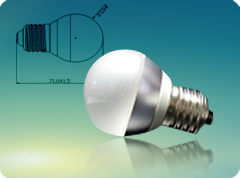The LED is relatively inexpensive and is becoming more popular in electronic control circuits for air conditioning, heating, and refrigeration systems. There is no filament to burn out requiring replacement of the LED. They are used as pilot lights as indicators and on numerical displays to indicate system operation. They are used on electronic thermostats to indicate the condition that the system is operating under.
Operation: When the standard P-N junction diode absorbs light it can produce an electrical current. When the diode is under a forward-bias condition the light is emitted because of the recombining of the electrons and holes in the junction.
The LED and the junction diode are very much alike in many ways. Both of them are rectifiers and will allow current to flow in only one direction. The major difference is that the LED has a higher voltage drop across it than the junction diode. A silicone junction diode requires about 0.7 volts for it to turn on. The LED requires about 1.7 volts to turn it on. The LED is more difficult to test with an ohmmeter because of this higher voltage drop, because the ohmmeter must provide the required voltage to turn the LED on. Most ohmmeters are not capable of producing this high a voltage. To test an LED it is usually easier to build a circuit including the LED and see if it will operate as desired.





